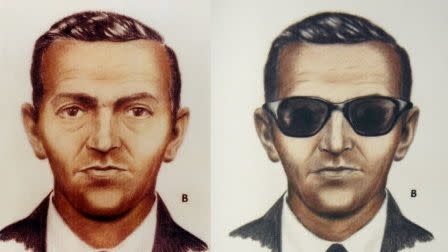A Staggering New Clue on D.B. Cooper's Tie Has Blown the 52-Year-Old Case Wide Open
- Oops!Something went wrong.Please try again later.

This story is a collaboration with Biography.com.
You wouldn’t jump out of an airplane wearing a tie. So, naturally, the most famous skyjacker to never be found, the dapper D.B. Cooper, took his tie off on Thanksgiving Eve, 1971, just before dropping out of a Northwest Orient Airlines plane somewhere south of Seattle.
Now, 52 years later, Eric Ulis—the amateur sleuth who has made it his mission to solve the enduring D.B. Cooper mystery—thinks the infamous tie yields enough clues to finally reveal the skyjacker’s true identity.
“I would not be surprised at all if 2024 was the year we figure out who this guy was,” Ulis recently told Fox 13 Seattle.
Ulis has been fighting to free D.B. Cooper’s tie from FBI holds, even suing the government for access, saying that the 100,000 particles left behind on the clip-on fashion accessory can tell the definitive story about just who the tie belonged to, and where it traveled.
While hampered by the non-compliance of the FBI, Ulis says the $1.49 tie—purchased from JCPenney around Christmas 1964, and found on seat 18-E of the fateful airliner—contained a unique particle that was part-stainless steel and part-titanium.
Ulis tracked that smidge of detail from a decade-old scientific report on the Cooper case and used U.S. patent information to trace various particle fragments from the tie to Crucible Steel of Pennsylvania. Now, Ulis just needs access to the tie to bring modern technology into the fray.
“Headquartered in the suburbs of Pittsburgh, a significant subcontractor all throughout the 1960s, it supplied the lion’s share of titanium and stainless steel for Boeing’s aircraft,” Ulis said of the metal-fabric shop.
Experts believe that anyone skyjacking the plane the way D.B. Cooper did must have possessed insider knowledge of the Boeing 727 and of the Pacific Northwest. Crucible Steel workers regularly made the trip from Pennsylvania to Boeing’s headquarters in Seattle.
Ulis tracked the now-defunct company’s assets over the decades and picked through historical records to land on a specific person of interest: a man who worked at the company and was also in Seattle around the time of the skyjacking.
“This is also the time, 1971, when Boeing had this significant downtown,” Ulis said. “It’s reasonable to deduce that D.B. Cooper may well have been part of that downturn.”
Pinpointing his fixation on a specific titanium research engineer from Pittsburgh, Ulis thinks he has a strong lead. “I can put him in Seattle, I can put him at Boeing,” he said about the man that died in 2002. “He’s a compelling person of interest. He’s definitely someone I’m going to continue to dig into.”
When it comes to cold cases, few continue to simmer quite like the D.B. Cooper case, the only unsolved commercial airline hijacking in history. The unknown skyjacker—he called himself Dan Cooper, but the media misreported the name as D.B. Cooper, which stuck— paid $18.52 cash for a one-way ticket to Portland and boarded Northwest Orient Flight 305 on November 24, 1971, boarding the flight without offering up identification due to a lack of regulations at the time.
Along with a strong knowledge of airplanes and parachutes, law enforcement officials believe D.B. Cooper had a solid connection to the Pacific Northwest based on comments he made during the flight about the terrain below.
Carrying with him a briefcase and paper sack, Cooper passed a note to a flight attendant seated behind him halfway through the flight and whispered that she better look at the note since he had a bomb. Cooper opened his briefcase to reveal what appeared to be a bomb and then relayed his demands of $200,000, multiple parachutes, and a refueling truck on the ready in Seattle so he could take off again, bound for Mexico City.
The demands were met, and the planned 30-minute flight turned into two hours of circling the Puget Sound as crews readied on the ground. The airliner’s 35 passengers were released, along with some of the crew, and Cooper negotiated the specifics of the flight path and plane setup—he required a set speed, flap angle, and plenty more—before he took off again with four crew on board.
Somewhere still over Washington, Cooper then opened the rear staircase and parachuted from the plane, but the exact location and timing is unknown. Immediate searches yielded no evidence, and over the years, experts have been unable to determine an exact search area due to the multiple variables involved in the night jump.
In 1978, a hunter found a placard with instructions for lowering the aft stairs of a Boeing 727. Then, in 1980, an 8-year-old vacationing along the Columbia River near Vancouver, Washington, found three packets of the ransom money in the sand along the river’s edge.
The FBI still has that necktie, though, so the quest for D.B. Cooper answers continues to raise new questions.
You Might Also Like
